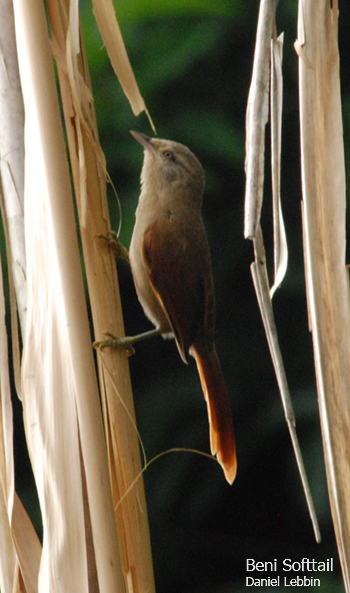 Beni Endemic Bird Area Beni Endemic Bird Area
by Bennett Hennessey Updated Nov 2018
Bolivia is the world’s most diverse land locked country. Bolivia could not be better placed in South America to cover more habitat types, but the downside to this for the birder psyche is that Bolivia has few political endemic species. Most of the habitats in Bolivia are shared with its neighbours, which means that most of the birds are also shared with neighbouring countries. This is why political endemism is not the best measure of a species’ distinctness in Bolivia. There are over 70 Bolivian bird specialities that most birders will never see outside of Bolivia (see Bolivian Specialities section).
Three habitats are distinctly Bolivian, each with their own sexy flagship species: The Bolivian Andean Cerrado with the Palkachupa Cotinga, the Dry Andean Valleys with the Endemic Red-fronted Macaw, and the Beni Savannah with the Blue-throated Macaw.
The Blue-throated Macaw and the Unicolored Thrush are the two “official” Endemics of the Beni Endemic Bird Area, but there are many more species that birders should be aware of. Here I have pasted three Nature Serve range maps. You should see an interesting similarity in species distributions.
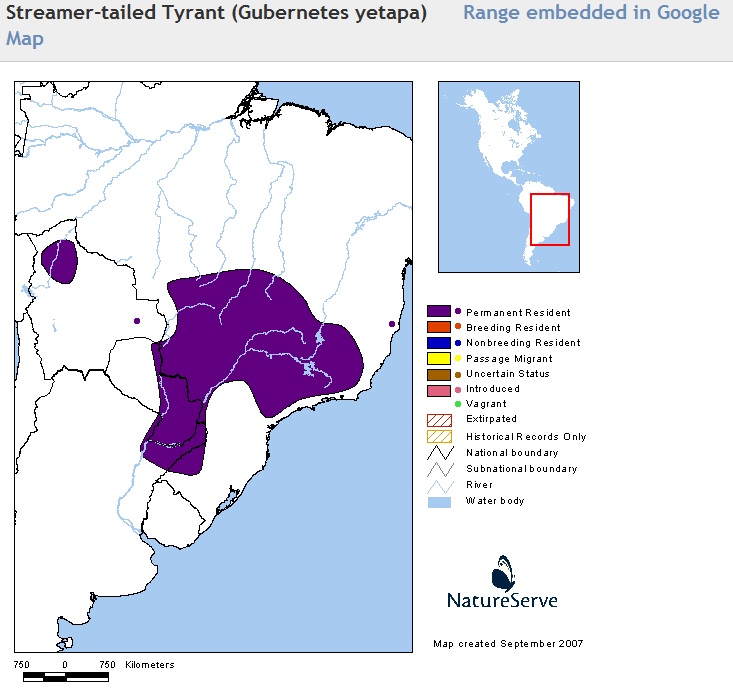
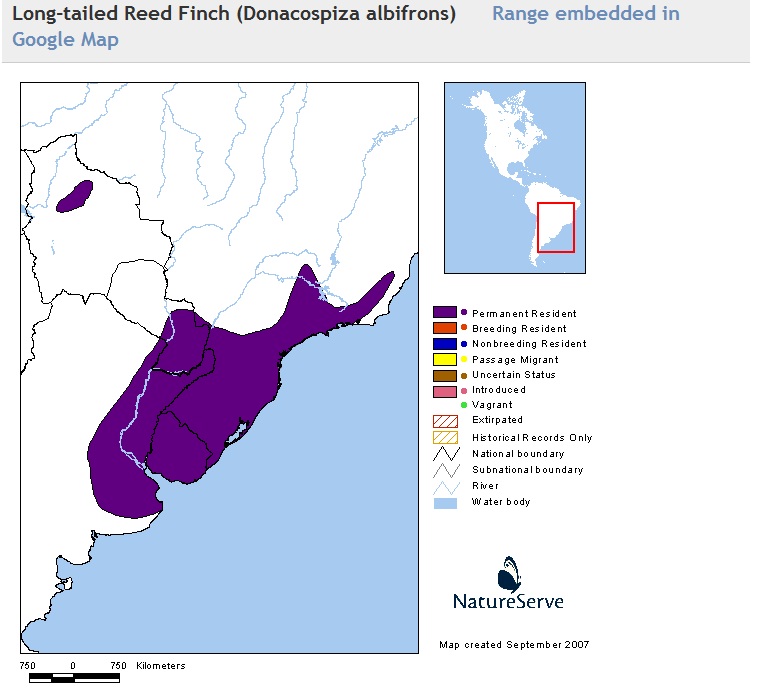
There is a group of bird species which are found in the Temperate savannahs of Argentina, and then again in the Tropical seasonally flooded savannahs of Beni; between the two is non-savannah habitat of Pantanal, Dry forest, Chaco and Cerrado. For most of these species, the reproductive isolation in the Beni Savannahs does not mean they are species- but it hints that they could be. It all depends on how long they have been isolated, and the extent of their evolutionary changes during that time.
 The Beni Savannah avifauna has been poorly studied. The species' distinction decisions have been based on collected specimens, with little scientific studied data on song, habitat variation, behaviour, reproduction, and genetic variation. For example, the Greater Pampa Finch has a healthy population in the seasonally flooded Beni lowland Savannahs, but then there is a gap in the distribution, until you find the bird in Andean dry valleys at 1500 m above sea level. I found the Andean Pampa Finch in the Red-fronted Macaw Reserve. Knowing its odd isolated population in the Beni, I conducted playback experiments in the Andes playing the song of the Beni Pampa Finch from the Barba Azul Nature Reserve. The Andean bird completely ignored the song- no reaction whatsoever. Then I played the song of the Andean Greater Pampa Finch from Tarija, and the individual flew to a nearby overhanging perch and started singing and displaying with gusto. This is highly suspect that the two birds would not interbreed if living together, and therefor are probably different species. The Beni Savannah avifauna has been poorly studied. The species' distinction decisions have been based on collected specimens, with little scientific studied data on song, habitat variation, behaviour, reproduction, and genetic variation. For example, the Greater Pampa Finch has a healthy population in the seasonally flooded Beni lowland Savannahs, but then there is a gap in the distribution, until you find the bird in Andean dry valleys at 1500 m above sea level. I found the Andean Pampa Finch in the Red-fronted Macaw Reserve. Knowing its odd isolated population in the Beni, I conducted playback experiments in the Andes playing the song of the Beni Pampa Finch from the Barba Azul Nature Reserve. The Andean bird completely ignored the song- no reaction whatsoever. Then I played the song of the Andean Greater Pampa Finch from Tarija, and the individual flew to a nearby overhanging perch and started singing and displaying with gusto. This is highly suspect that the two birds would not interbreed if living together, and therefor are probably different species.
I found the same thing with the Beni Long-tailed Reed-finch. The bird is poorly known in Bolivia with no sound recordings I can find. Upon finding the species near Trinidad, I played the song of its Argentinean relatives, but they did not respond. It is important to sound record the species to compare vocalizations, as this could be a different species.
Other species in Beni experienced ornithologists know are Beni Endemic Bird Area species but no-one has taken the time and effort to conduct studies to prove to the world in a scientific paper that they are species. This is the case for the Plain Softail and the Velvet-fronted Grackle that will be the Beni Softail and the Beni Grackle once someone does the work.
Below is a list of bird species that could be species endemic to the Beni. These are species that birders should try to see in the Beni. Note the subspecies name for future reference when many of these will be shown to be true Beni Endemic Bird Area species.
Plain Softtail Thripophaga fusciceps fusciceps– All experts agree, this is not the same species. Strong variation in behaviour (species is gregarious with family nesting), vocalizations, habitat, and nesting. Someone just needs to write it up. Beni Softtail please. Best place to see in San Ramon, Trinidad.
Gray-crested Cacholote Pseudoseisura unirufa - A recent split from the Rufous Cachalote. There is an odd gap between two populations.
Streamer-tailed Tyrant Gubernetes yetapa –Big gap in the population distribution. Little is known of the Bolivian birds. Best place to see in Barba Azul Nature Reserve.
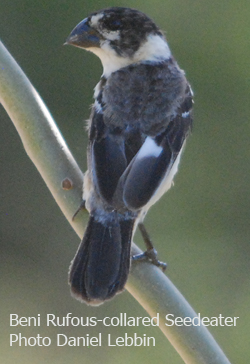 Great Pampa-finch Embernagra platensis – the birds in the Beni are not even distinguished to subspecies. They should be Embernagra platensis beniana. Slight plumage variation, and there would appear to be strong song variation. Best place to see in Barba Azul Nature Reserve and Trinidad area. Great Pampa-finch Embernagra platensis – the birds in the Beni are not even distinguished to subspecies. They should be Embernagra platensis beniana. Slight plumage variation, and there would appear to be strong song variation. Best place to see in Barba Azul Nature Reserve and Trinidad area.
Long-tailed Reed-finch Donacospiza albifrons –Distant isolated population in Bolivia, Donacospiza albifrons beniana. In a brief test, birds ignored playback Argentinian song. Best place to see in Trinidad area.
Black-masked Finch Coryphaspiza melanotis – Isolated population in Beni Savannas. Best place to see in Barba Azul Nature Reserve.
Rufous-collared Seedeater Sporophila collaris ochrascens- Alvaro Jaramillo writes in the Handbook of the birds of the world Vol 16, "Some birds in extreme NE part of range essentially black and white..." All birds on the Barba Azul Nature Reserve are black and white. Jaramillo states "further study needed".
White-bellied Seedeater Sporophila leucoptera bicolor- Alvaro Jaramillo writes in the Handbook of the birds of the world Vol 16, “Bolivian race bicolor quite different in appearance from others, and may warrant treatment as a separate species.” Best place to see in Botanical Gardens, Santa Cruz. Map from Xeno-canto. 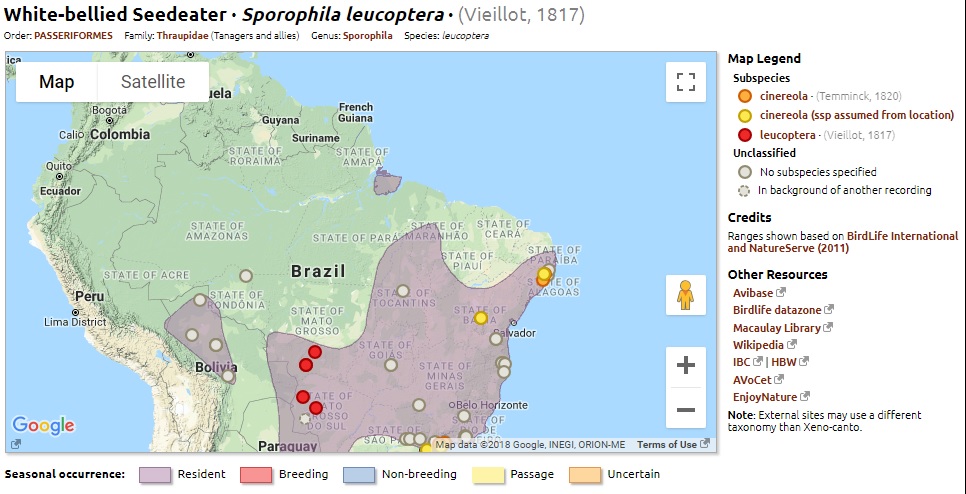
Capped Seedeater Sporophila bouvreuil – 800 km between the isolated Bolivian population. I do not know a good site for this species.
Ashy-headed Greenlet Hylophilus pectoralis Song variation suggests could be a different species. Best place to see in Barba Azul Nature Reserve and Laguna Suerez.
Velvet-fronted Grackle Lampropsar tanagrinus boliviensis. Experts agree, the birds in the Beni are not the same species. Beni Grackle please. Best place to see in San Ramon, Trinidad.
|

